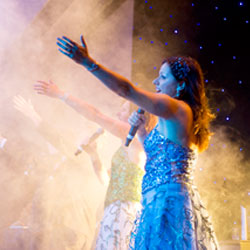Picasso famously said “All children are born artists. The problem is to remain artists until we grow up.”
If you enter a kindergarten you will encounter some of the best creative thinking anywhere: finger paintings with pink and green people and blue dogs and polka-dot skies, imaginative stories of fairies and magical, far-away places. Young children are naturally creative. They must create ways to learn and construct a world view from a collection of initially disconnected events, colours, movement and sound. So what happens between the open, effortless experimentation of our childhood and the blocks in creative thinking experienced by many adults?
Why do we discourage creativity in favour of facts and logic? Kobus Neethling conducted a 15 country research project showing that creative behaviour diminishes from 98% in the 3-5 year old age group to 32% by age 10: by the time children are turning 15, only 10% are behaving creatively and it’s only 2% by the age of 25. No wonder current statistics show that more than 80% of people are not engaged at work.
All kids have tremendous talents and we squander them, often ruthlessly, through creating Maths and English androids instead of thinking and feeling human beings.
We often talk about emotional intelligence or EQ, yet it is not a significant part of the way we educate our students. As children grow up we seem to focus on their heads and slightly to one side. Why do we almost completely focus on the left side of the brain in our educational and corporate worlds?
Professor Simon Majaro of Cranfield says: “There has been such a push to the left, mathematical, quantitative and analytical side of the brain that the software of the brain on the right has been neglected.”
Read this poem and please let me know how you think we can bring creativity back and find our real selves beyond the boxes life imposes on us.
School Made Him Square And Brown Inside (Poem)
He always wanted to explain things, but no-one cared.
So he drew.
Sometimes he would just draw and it wasn’t anything.
He wanted to carve it in stone or write it in the sky.
He would lie out on the grass and look up in the sky and it would only
be the sky and the things inside him that needed saying.
And it was after that that he drew the picture.
It was a beautiful picture. He kept it under his pillow and would let no-one see it.
And he would look at it every night and think about it.
And when it was dark and his eyes were closed he could see it still.
And it was all of him and he loved it.
When he started school he brought it with him.
Not to show anyone, but just to have it with him like a friend.
It was funny about school.
He sat in a square brown desk like all the other square brown desks
and he thought it would be red.
And his room was a square brown room, like all the other rooms.
And it was tight and close. And stiff.
He hated to hold the pencil and chalk, with his arm stiff and his feet
flat on the floor, stiff, with the teacher watching and watching.
The teacher came and spoke to him.
She told him to wear a tie like all the other boys.
He said he didn’t like them and she said it didn’t matter.
After that they drew. And he drew all yellow and it was the way he felt about
morning. And it was beautiful.
The teacher came and smiled at him. What’s this? She said.
“Why don’t you draw something like Ken’s drawing?
Isn’t it beautiful?”
After that his mother bought him a tie and he always drew airplanes
and rocket ships like everyone else.
And he threw the old picture away.
And when he lay out alone looking at the sky, it was big and blue;
and all of everything, but he wasn’t anymore.
He was square and brown inside and his hands were stiff.
And he was like everyone else. All the things inside him that needed
saying didn’t need it anymore.
He had stopped pushing. He was crushed.
Stiff.
Like everything else.
Author: Written by an English schoolboy
Reference: http://www.edirisa.org/studioarchive/?p=651





